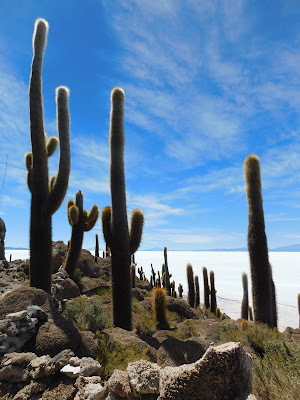We were told not to wear ‘posh’ shoes today as we are to go to the Salar de Uyuni (Salt Lake) where the surface may be soft and shoes soaked in salt do not last very long. I did manage to get ankle deep in soft salt but when I washed my sandals later they came out looking very clean. Just hope they do not fall apart later! This lake is the largest salt flat in the world sitting at an altitude of 3653 metres and is part of a prehistoric salt lake, Lago Minchin, which once covered the south west of Bolivia. It has a surface area of 246 square metres and the distance north to south is 180 klms while east to west is 120 klms.
Leaving the town we first went to Colchani where we were shown how the salt was processed, it being mixed with xxx then dried and bagged. The salt processed from the lake is not exported but is enough for the countries use. Many of the houses were built with salt blocks which are environmentally friendly and also keep the house heated and cool in the different seasons.
Foreign countries, for the moment, are banned from mining for salt as they destroy the lake by their extreme mining methods. Salt is scraped from the surface of the lake by a blade attached to a tractor and then collected. All collection and processing is done by 80 families who have had rights to the salt for generations and want their way of collecting salt to continue. The lake also contains 50% to 70% of the world’s reserves of lithium, more than enough reason for the big mining groups to come into the country and devastate the lake in their quest for the lithium. The lake itself has been declared a national park and people wonder how long it will stay like that when a huge amount of money could be earned through mining.
 |
| Cars on the salt surface of the lake |
 |
| Piles of salt on the lake |
The salt is formed by rainwater falling onto the existing solid salt crust underneath which there is a layer of brine 2 to 20 cms deep, the rain water being changed changed to salt water then evaporated by the sun leaving a ‘thin’ layer of salt behind. This is the layer that is collected with the original surface being allowed to continue.
 |
| Old hotel on the lake |
No buildings are allowed on the salt lake though one hotel was built there in the past but due to environment issues it has since been closed down.
 |
| Dakar Rally Monument |
For some unknown reason a monument has been built on the lake to commemorate the Dakar Rally which does drive through Bolivia but does not
drive on the lake.
In the middle of the salt flat is a hilly and rocky outcrop of land called Isla Incahuasi. It has a total area of 24.62 hectares (61 acres) and has gigantic cacti Trichocereus pasacana growing there. There are unusual and fragile coral-like structures and deposits that often consist of fossils and algae. The place is the top of the remains of an ancient volcano, which was submerged when the area was part of a giant prehistoric lake, roughly 40,000 years ago.
 |
The island in the salt lake
Photos of the Island |
 |
| Lunch |
 |
Salt block table
Every 31 August the people in the area take part in principal ceremony in the Andes asking the gods to favour them during the year to come. This requires copious amounts of beer or similar to be drunk over a three day period. |
 |
| Depiction of the feasting |
 |
| I just liked this painting |
Late afternoon we went to the edge of the lake and waited for the sunset after which it was back to the Hotel Tonito after a long day.


















No comments:
Post a Comment